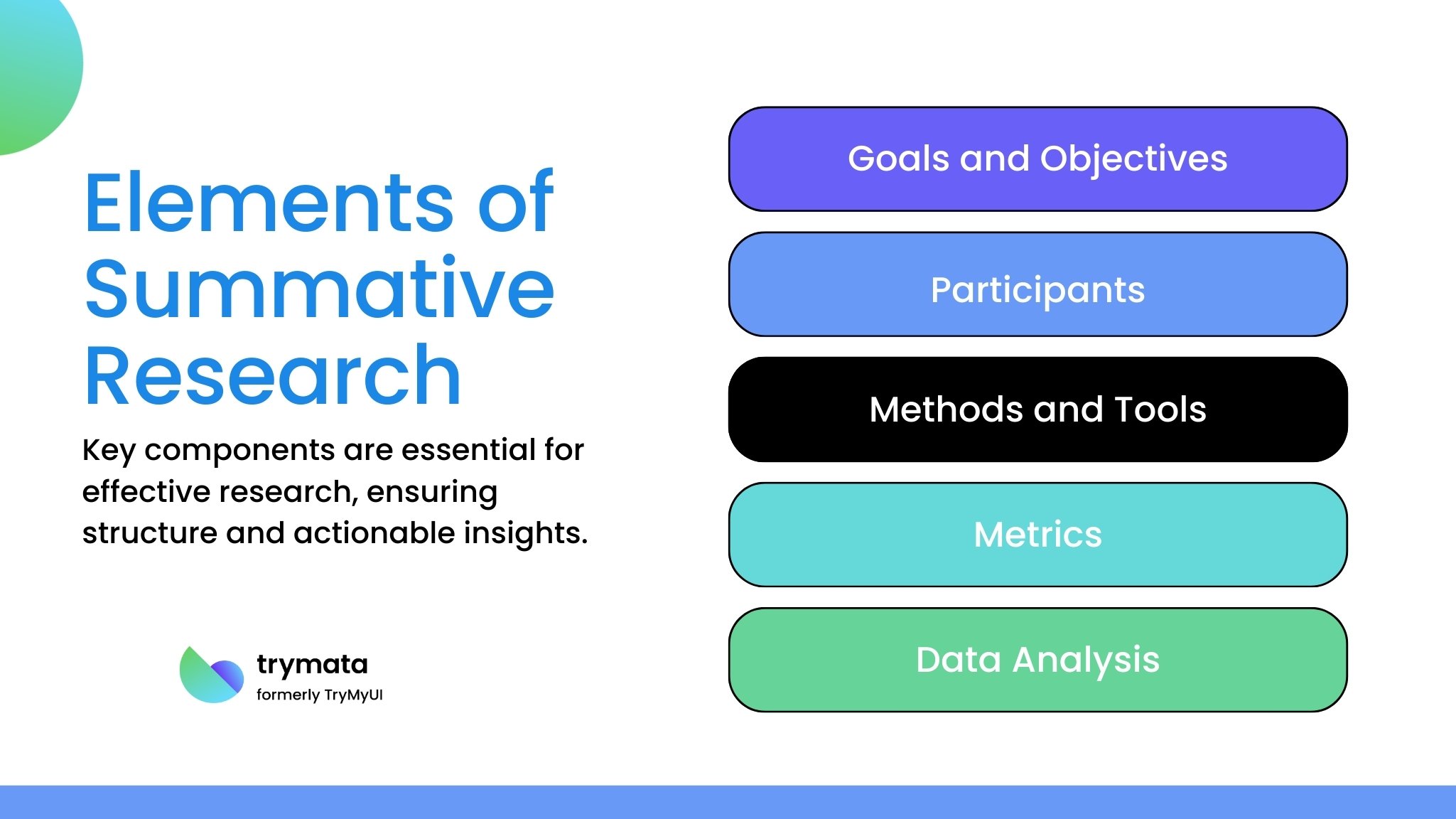Research plays a critical role in ensuring that products are functional and meet user expectations. Among the various research methods, summative research stands out for its focus on evaluation and effectiveness.
Whether you’re designing a website, app, or physical product, understanding and implementing summative research is essential to validate your design decisions and ensure user research satisfaction.
What is Summative Research?
Summative research is an evaluation method that measures the effectiveness, efficiency, and satisfaction of a product, service, or process. Conducted at the end of a development cycle, it’s primary goal is to assess whether the intended outcomes have been achieved.
In usability testing, summative research evaluates a product’s performance against predefined benchmarks or metrics.
Unlike formative assessment or research, which focuses on identifying problems and refining designs during the development phase, summative evaluation provides a final “grade” on the product. It answers questions like:
- Does the product meet its usability goals?
- How does the product compare to competitors?
- Are users able to achieve their objectives efficiently and effectively?
Why Is Summative Research Important in Usability Testing?
Summative research serves as a litmus test for the success of a product. Here’s why it’s vital:
- Validation of Design Choices: It verifies whether the design decisions made during the development process align with user needs and business goals.
- Stakeholder Communication: Summative research provides quantifiable data to be shared with stakeholders to demonstrate the product’s value.
- Benchmarking Performance: Measuring against industry standards or competitors helps identify areas for improvement and establish market positioning.
- Risk Mitigation: Identifying usability issues post-launch can be costly. Summative research minimizes this risk by uncovering potential problems before the product reaches users.
Elements of Summative Research
Understanding the key components of this is essential for conducting it effectively. These elements ensure the research is structured and yields actionable insights.

1. Goals and Objectives
Clearly defining the purpose of your summative research is crucial. Common goals include:
- Measuring task completion rates.
- Evaluating user satisfaction through surveys or interviews.
- Analyzing error rates and recovery times.
2. Participants
Selecting the right participants is essential for accurate results. Ensure your sample is representative of your target audience. Consider factors such as:
- Demographics.
- Technical proficiency.
- Context of product use.
3. Methods and Tools
Summative research employs a range of methods, including:
- Usability Tests: Observing users as they interact with the product.
- Surveys and Questionnaires: Gathering subjective feedback on user experience.
- A/B Testing: Comparing two design versions to determine which performs better.
- Analytics Tools: Data collection on user behavior, such as click-through rates or session durations.
4. Metrics
Key performance indicators (KPIs) in summative research often include:
- Effectiveness: Task success rate, error rate.
- Efficiency: Time to complete tasks, ease of navigation.
- Satisfaction: User ratings, Net Promoter Score (NPS).
5. Data Analysis
Analyze both quantitative and qualitative data to draw meaningful insights. Use statistical methods to validate findings and identify patterns or anomalies.
Steps to Conduct Summative Research for Usability Testing
Summative research involves structured steps to ensure reliable and actionable outcomes. Here’s a step-by-step guide to get started.
Step 1: Define Research Objectives
Start by setting clear, measurable goals. For example:
- “Determine if 80% of users can complete the checkout process within 3 minutes.”
- “Achieve a user satisfaction score of 4 out of 5 or higher.”
Step 2: Develop a Test Plan
Create a detailed plan outlining the following:
- Research questions.
- Participant criteria.
- Tasks to be tested.
- Metrics to be measured.
Step 3: Recruit Participants
Select participants who closely resemble your target audience. Use recruitment platforms, social media, or customer databases to find suitable candidates.
Step 4: Conduct Usability Tests
Facilitate sessions in which participants complete tasks while you observe and record their interactions. Ensure the environment mirrors real-world conditions to increase the validity of the results.
Step 5: Collect Data
Gather both quantitative data (e.g., task completion times and error rates) and qualitative research data (e.g., user feedback).
Step 6: Analyze the Results
Use statistical tools to interpret data. Identify trends, correlations, and areas needing improvement.
Step 7: Report Findings
Prepare a comprehensive report that includes:
- Key user insights.
- Visualizations (charts, graphs).
- Recommendations for design process improvements.
Examples of Summative Research in Action
Real-world applications of summative research showcase its value in validating designs and ensuring usability. Here are a few illustrative case studies.
Case Study 1: E-Commerce Website
An online retailer conducted this approach to evaluate their redesigned checkout process. Key findings included:
- A 95% task success rate.
- Average completion time of 2 minutes.
- User satisfaction score of 4.5/5. These results validated the redesign’s effectiveness, leading to a successful launch.
Case Study 2: Mobile App
A fitness app developer used summative research to assess a new feature. Insights revealed:
Users struggled to find the feature in the menu.
- The feature’s usage rate was 30% lower than anticipated.
- Recommendations included simplifying the navigation and providing in-app tutorials.
Best Practices for Summative Research
Following best practices ensures the effectiveness of summative research and maximizes the reliability of its findings. Incorporate these tips for success.
- Start with Clear Objectives: Avoid vague goals; instead, focus on measurable outcomes.
- Use Realistic Scenarios: Design tasks that reflect actual user behavior.
- Combine Quantitative and Qualitative Methods: A holistic approach ensures comprehensive insights.
- Pilot Test Your Plan: Conduct a trial run to identify potential issues before full implementation.
- Communicate Findings Effectively: Use visuals and concise language to share results with stakeholders.
Challenges and How to Overcome Them
Summative research presents unique challenges. Understanding and addressing these hurdles ensures smoother execution and more reliable outcomes.
- Limited Resources
Solution: Prioritize critical tasks and focus on high-impact areas.
- Recruiting Participants
Solution: Leverage online recruitment tools and incentivize participation.
- Data Interpretation
Solution: Collaborate with data analysts or use user-friendly analytics tools.
Conclusion
Summative research is an essential component of usability testing. It clearly shows a product’s effectiveness, efficiency, and user satisfaction. By following a structured approach and leveraging the right tools, teams can ensure their products meet user needs and stand out in competitive markets.
Whether you’re launching a new app, refining a website, or developing a physical product, it provides the insights needed for success.
Incorporating this into your usability testing strategy validates design choices and fosters a culture of continuous improvement. Embrace this powerful method to deliver exceptional user experiences that drive satisfaction and loyalty.




